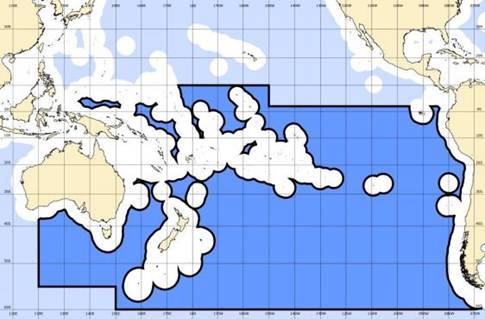The South Pacific Regional Fisheries Management Organisation (SPRFMO) entered into force on 24 August this year.
"The South Pacific Regional Fisheries Management Organisation is an inter-governmental organisation that is committed to the long-term conservation and sustainable use of the fishery resources of the South Pacific Ocean and in so doing safeguarding the marine ecosystems in which the resources occur". The SPRFMO was established in terms of the Convention on the Conservation and Management of High Seas Fishery Resources in the South Pacific Ocean.
The new RFMO covers South Pacific high-seas fisheries: benthic, demersal and pelagic. Its current members are Australia, Belize, Chile, Cook Islands, Cuba, European Union, Denmark (in respect of the Faroe Islands), South Korea, New Zealand and Russia.
The first meeting of the SPRFMO's Commission will be held from 28 January to 1 February in Auckland, New Zealand. This will follow on from the Eleventh Meeting of the Scientific Working Group (SWG-11) and its subgroups in Lima, Peru over 15-19 October 2012. Now that the SPRFMO has come into force the SWG will be replaced by a Scientific Committee following its last meeting in Peru.
The Convention's text inter alia states "fishing shall be commensurate with the sustainable use of fishery resources taking into account the impacts on non-target and associated or dependent species and the general obligation to protect and preserve the marine environment" and that both a precautionary approach and an ecosystem approach will be applied.

Region covered by the South Pacific Regional Fisheries Management Organisation
Although the Convention's text makes no specific mention of seabirds it is assumed that they will be included as "non-target species" when applying a precautionary and ecosystem approach to management of fisheries within the region covered by the SPRFMO. In this regard it is to be noted that conservation and management measures to be adopted by the Commission shall include measures "to maintain or restore populations of non-target and associated or dependent species to above levels at which their reproduction may become seriously threatened". The Convention text also allows for defining "the types of fishing gear, fishing technology, or fishing practices which may be used when fishing", which will presumably allow for the deployment of bird mitigation measures, such as bird-scaring lines where considered desirable.
John Cooper, ACAP Information Officer, 31 August 2012

 English
English  Français
Français  Español
Español